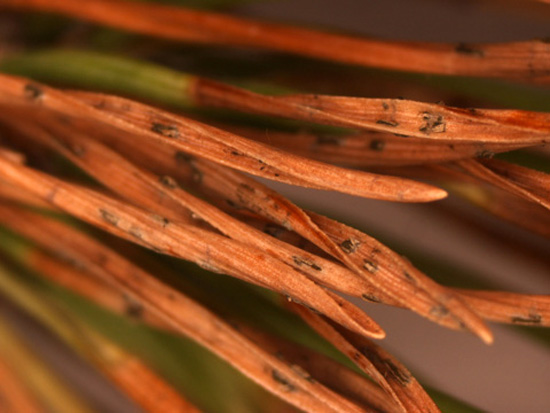Introduction
Brown spot needle blight is a fungal disease of pine trees. The disease is caused by the pathogen, Mycosphaerella dearnessii. The damage produced by brown spot needle blight resembles that of the Dothistroma and Lophodermium needle blight diseases. Brown spot needle blight induces the formation of needle spots. It also promotes the browning of infected needles. Infected needles are often shed prematurely. Successive defoliations of host trees can inhibit growth, and reduce tree vigor. Severe infections may culminate in tree mortality.
Distribution & Habitat
Brown spot needle blight occurs throughout the United States. Infections are frequently reported in the southern states, but may also be observed in the northeastern and midwestern states.
Hosts
Brown spot needle blight frequently infects longleaf pine, ponderosa pine, and Scots pine. Short-needled varieties of Scots pine are more susceptible to infection than the long-needled varieties. Infections of brown spot needle blight have also been observed on jack pine, mugo pine, Austrian pine, eastern white pine, and red pine, albeit with less frequency. Brown spot needle blight is most common on young trees, and saplings, though infections may occur on trees of all ages.
Disease Cycle
The fungus overwinters in the infected needles of host trees, as well as in any needles that have been shed by host trees. In late spring or early summer, fruiting bodies appear on the infected needles. The fruiting bodies rupture, and expel spores that are disseminated by splashes of rain, or air currents to nearby growth, where they initiate new infections. The potential for infection is heightened when conditions are warm, and damp. When the spores are released, fhe fungus infiltrates the stomata of susceptible needles. The fungus resides within the needles for forty eight hours before germinating. When conditions are not as favorable, a longer germination period may be required. Once the fungus has become established, it develops within the needle tissue throughout the growing season. In late spring or early summer of the following year, fruiting bodies appear on the infected needles, and the cycle begins anew. Once the disease has become established in an area, annual infections will often occur.
Symptoms of Infection
Brown spot needle blight causes infected needles to turn brown, or reddish-orange. Infected trees will often only display a single year of growth. Infected branches become sparse, with only a few small tufts of needles remaining at the tips. Damage from brown spot needle blight initially appears on the lower branches. As the infection progresses, it gradually affects the upper branches as well. From May to September, yellow to brown spots develop on the infected needles. During summer, the spots coalesce into bands that encircle the needles. The bands may occur at any section of the needle. The needles may become soaked in resin exuded from the host tree. By early fall, as the surrounding tissue dies back, pale yellow lesions may appear raised on the needles. Finally, the needles expire, and are shed from the tree. Some needles may linger on the branches through winter.
Management
- Plants can generally withstand light infections. To ensure that infections do not increase in severity, remove, and promptly dispose of diseased needles on host plants. When excising infected branches, sterilize pruning equipment between each cut. Use a solution comprised of nine parts water and one part bleach.
- Prune dense foliage, and lower branches to improve air circulation, and promote drying of wet needles.
- Promptly rake, and dispose of any needles that are shed from host plants. This will reduce the number of potential infection sites for the disease pathogen.
- If a susceptible tree is planted in a landscape setting that has an irrigation system installed, ensure that the needles remain clear of the water.
- Water trees early in the morning, so that the needles have ample time to dry in the afternoon.
- Maintain plant vigor through sound cultural practices. Ensure that plants are sufficiently watered, especially during periods of extended drought. Apply a layer of organic mulch around the base of plants to improve soil quality, moderate soil temperature, and retain soil moisture.
- Copper-based fungicides may be applied to combat the disease. Applications should be performed when the needles are ¾ of an inch to 1 ¼ inches long. A second application should be administered three to four weeks later.
- When planting, consider selecting resistant tree species. Plants that exhibit an increased resistance to brown spot needle blight include spruce, arbovitae, and juniper.
Photo courtesy of Travis Cleveland, Plant Clinic


